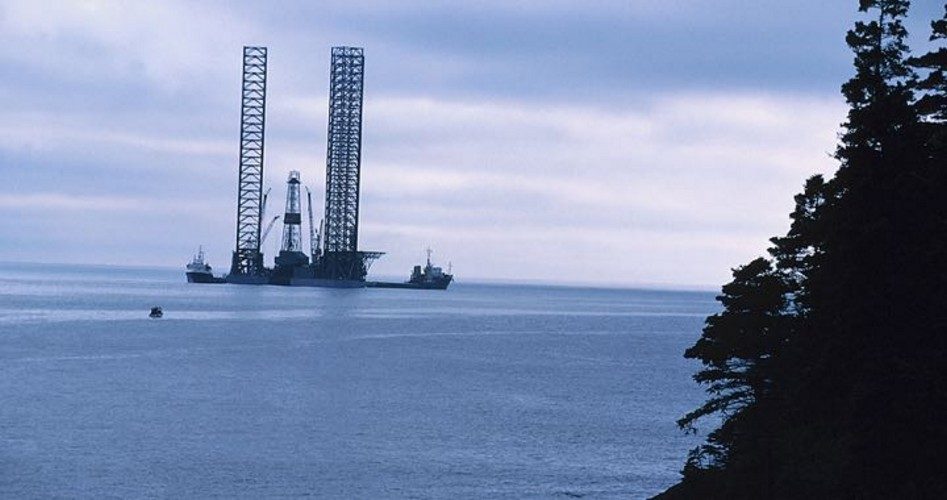
President Trump’s Interior Secretary Ryan Zinke was very careful in announcing his agency’s next step in expanding energy development to include the United States’ offshore reserves. He knew that environmentalists and far-left politicians would attack his plan and did what he could to placate them in advance. Said Zinke:
Responsibly developing our energy resources on the Outer Continental Shelf [OCS, defined in general as extending from 3 miles out to 200 miles off the nation’s coastline] in a safe and well-regulated way is important to our economy and energy security, and it provides billions of dollars to fund the conservation of our coastlines, public lands and parks.
Please note Zinke’s careful use of environmentalists’ own words in his announcement: “responsibly,” “safe,” “well-regulated,” and “conservation.” But anti-fossil fuel environmentalists and politicians on the Left weren’t buying any of it. Most of the noise came from California, which hasn’t allowed off-shore drilling on its coastline since 1969. Governor Jerry Brown called Zinke’s move a “reckless, shortsighted action,” while House Minority Leader Nancy Pelosi (D-Calif.) accused Zinke of threatening to “loot” the planet:
The Trump administration is racing forward with its increasingly brazen attempts to loot our environment and our planet. Americans from coast to coast will make their voices heard to oppose this blatant corporate giveaway.
California’s far-left lieutenant governor, Gavin Newsome, said California’s State Lands Commission, of which he is a member, will “use every power in its toolbox to ensure that not a drop of oil or gas from new offshore drilling ever makes landfall in California.” State Representative Jared Huffman (D-San Rafael) joined the chorus: “Californians will never let this happen. This reckless proposal for a new offshore drilling spree should face widespread bipartisan opposition. We’ll fight them in Congress, on the beaches, in the courts and at the ballot box. I’m confident we’ll defeat this dangerous plan.”
Just what is this “dangerous plan” that has these people all exercised? Is drilling about to start? Have leases already been purchased? Are wells about to come online? Not exactly. Said Zinke:
Today’s announcement lays out the options that are on the table and starts a lengthy and robust public comment period.
Just like with mining, not all areas are appropriate for offshore drilling, and we will take that into consideration in the coming weeks.
Translation: What Zinke is proposing is the start of a long, winding, likely to be noisy process that could lead to the sale of up to 47 potential leases starting in 2019. Selling those leases would then trigger the start of development, with the first drop of new oil not likely to appear above ground before 2022. Zinke called his proposal “an early step in a multi-year process to develop a final National OCS Program for 2019-2024.”
Once (and if) approved, the new plan would offer for sale 12 leases in the Gulf of Mexico, 19 off the coast of Alaska, seven in the Pacific Region (i.e., California, Washington, and Oregon), and nine in the Atlantic Region (i.e., from New York down to Florida).
But those sales would take place only after environmental impact statements have been filed and approved, not to mention settlement of various and predictable lawsuits to be filed by green organizations dedicated to the proposition that crude oil should remain in the ground “where it belongs.”
Once (and if) approved, the economic benefits could be substantial. Energy API said that through the year 2035, those leases could create 840,000 jobs, add about 3.5 million barrels a day to the country’s energy production, generate more than $200 billion in new revenues to the federal government, lead to half a trillion dollars in new private-sector investment, and add more than $70 billion a year to the U.S. economy.
Those are a lot of ifs. Other “ifs” include what crude oil will be selling for on the world markets in five years, what new technologies will have been developed by then to make extraction more efficient, less costly, and safer, and what other claims on investment capital could arise by then.
The New American noted last month that when the Trump administration put out for lease some 23 million acres in the National Petroleum Reserve — Alaska, it received only seven offers for 80,000 acres. Challenges in developing Alaska’s energy resources include intemperate weather, unproven reserves, and lack of infrastructure. Off-shore leases in the lower 48 states present much fewer roadblocks to such development. Nevertheless such development is years into the future despite howls of protests from the usual suspects in the green movement over Zinke’s announcement.
An Ivy League graduate and former investment advisor, Bob is a regular contributor to The New American magazine and blogs frequently at LightFromTheRight.com, primarily on economics and politics. He can be reached at [email protected].



